Railroad adventure V: Datong - Beijing Bei via Badaling
Going back from Datong to Beijing Bei (North), the train took a different route than on the outward trip. This route is very exciting since it goes very close to the Great Wall, and also features steep gradients (over 3 percent) and a switch-back).
We'll start at the Datong railway station, a monumental building. The letters on top say Da Tong zhan (station).
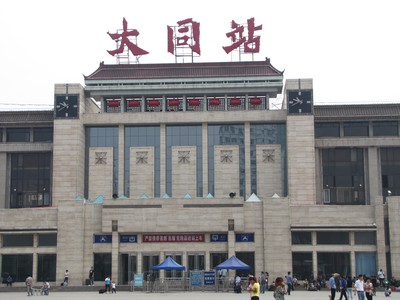
At first I thought that there was a huge line to get into the station, and I was happy to discover, though, that the lines were not to get into the station. Chinese railway tickets are sold a certain number of days in advance, and clearly these people were waiting to buy tickets to desirable destinations. I believe the large electronic board announces how many tickets are left for various destinations and in various classes. The Chinese railway system is underdimensioned for the demand, but China is building a lot of new railroads (again throwing light on my earlier comments about the endowed chair in railroad engineering which Yale has made into a general civil engineering chair).

The first part of the trip was uneventful. I covered this distance before, and the windows were even dirtier this time, making it hard to get good pictures. I did see a few interesting things that I did not see on the outward journey, such as this town with a city wall. I do not know its name, but I shall try to find out.
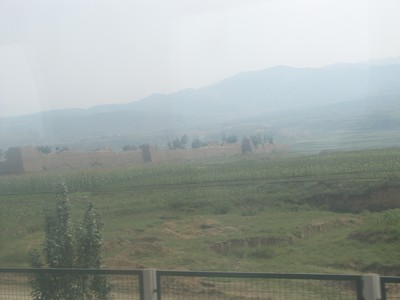
Chinese sheep.
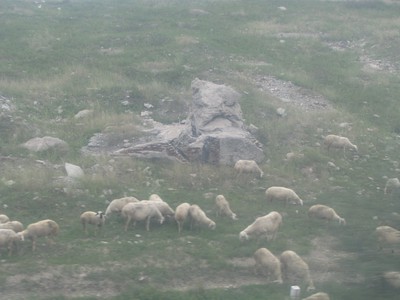
Wind power.

Each car has its own attendent, and I was fascinated and impressed by how conscientious the attendents were. The one in my car was very careful that all the luggage on the luggage racks was correctly placed, with no straps hanging down. He often had to climb a seat to reach, but he always used a piece of textile to climb on. (I would be good as a car attendent, for I am able to reach the overhead spaces without climbing the seats!). When he was not doing anything in particular, he still sat and watched over the car from his own little compartment at the end.
A funny detail was when the tickets where checked. Then the attendant came first and shouted "Tickets up" (I think I recognized these words). Then three conductors came and quickly punched everyone's ticket. No "thank yous" or other small talk, just a very efficient operation.
Note, this is a hard seat car (second class). Still airconditioned, and very clean. In fact the attendant was constantly cleaning the floors. I had to lift my feet five times in seven hours to allow him to sweep or mop the floor!

When we had a longer stop, the attendant in the soft seat-car (first class) even polished the sign indicating the origin and destination of the train.

That sign, after being polished. The train ran from Huhehaote (Hohhot) in Inner Mongolia to Tongliao (also in Inner Mongolia). This is a trip of 1478 kilometers that it makes in 25 hours and 15 minutes.
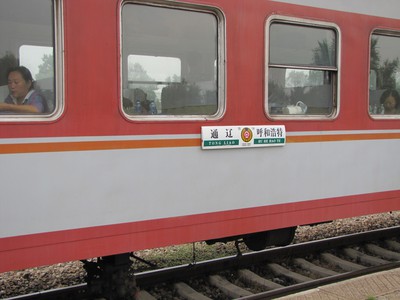
By the way, the train was five minutes late from Datong, but we still arrived two minutes early in Beijing.
Soon after Xuanhua, where we changed engines from an electric to a diesel, the tracks we followed diverged from those that I had followed on the outward journey. There was now single track, with wooden sleepers, and no longer any electric overhead wire and no continuously welded tracks (clickety-clack!). We were getting in on the old line from Beijing to the northwest, to so-called Jingzhang railway. It was built between 1905 and 1909 (when China was still ruled by the imperial dynasty of Qing).
The train stopped for over 20 minutes in Kangzhuang in order to attach a help engine to the end of the train. We were going to be going downhill at steep gradients down to the plain around Beijing, and the train must have needed the extra breaking power.
The train ride between Kanzhuang and Nankou (where the help engine was removed) is spectacular. Not only is the natural scenery magnificent. The track goes in a narrow gorge with high and steep mountains on both sides, but it also gets very close to the Great Wall of China. This is the most famous section of the wall, the one closest to Beijing, and thus the one most visited by tourists. I got many pictures of the wall. Sadly, the dirty windows and the ever denser fog conspired to make the image quality rather poor. Here are, at any rate, some of the best.

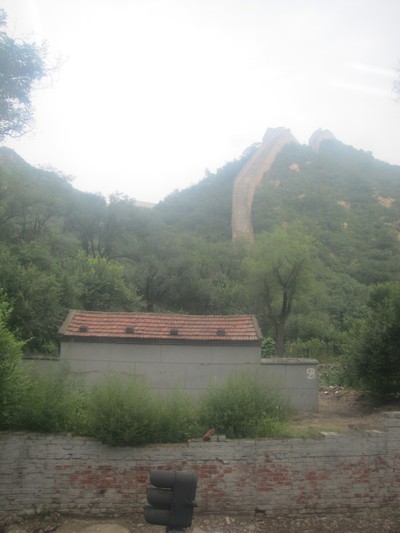
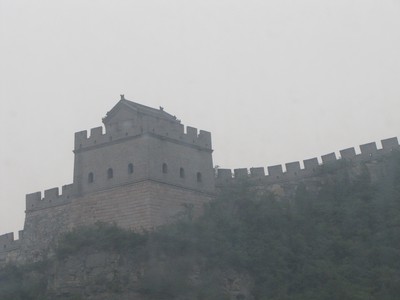
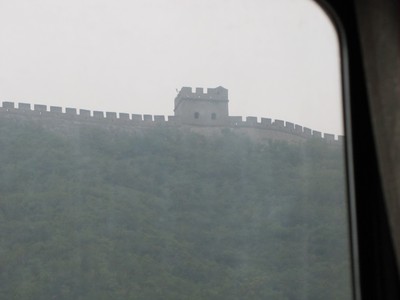
Just after Badaling station (where we did not stop), the train passed through a tunnel, which must have been about 2 kilometers long. Just after the tunnel we arrived at Qinglongqiao station where there is a switchback. The train stops on the station, then changes direction to go down a different track after the switch have been changed. In this way a very steep gradient can be avoided. The railway does still have a very steep gradient, up to 33 pro mille (greater than on the Gotthardbahn, see Adventure II). So we stopped, and reversed. Then the train went very slowly and carefully downhill.
In the picture one sees the lower of the two rails, photographed from the train which is still on the upper rail.

The Jingzhang railway is the first railway in China to be financed, engineered and built by native Chinese. The engineer in charge was 詹天佑, Jeme Tien Yow (1861-1919; with modern pinyin transliteration his name would be Zhan Tianyou). Jeme graduate from Yale College in 1881 with a degree in civil engineering with specialization in railway engineering! (I hope you can see why I still wonder why Yale got rid of our endowed chair in railway engineering!). He was buried at the switchback, where his statue also stands (on his grave?).

A photograph of him, borrowed from Wikipedia.
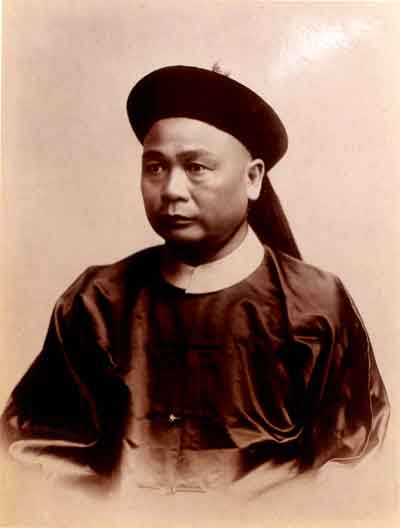
There were several switchbacks in Sweden. One of them was on the narrow-gauge Hörken-Fredriksberg-Neva railroad, and the switch was at Lövsjön, which is about 50 kilometers from Ludvika, today in the middle of nowhere. I visited the site together with my father and my children last month! Alas, I did not have my camera with me then, but I found a recent photo on a webpage.
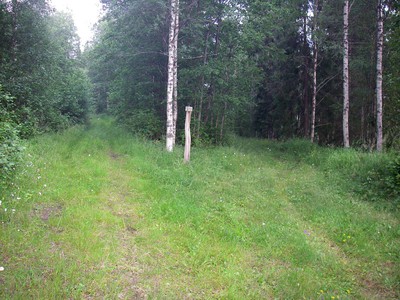
We'll start at the Datong railway station, a monumental building. The letters on top say Da Tong zhan (station).

At first I thought that there was a huge line to get into the station, and I was happy to discover, though, that the lines were not to get into the station. Chinese railway tickets are sold a certain number of days in advance, and clearly these people were waiting to buy tickets to desirable destinations. I believe the large electronic board announces how many tickets are left for various destinations and in various classes. The Chinese railway system is underdimensioned for the demand, but China is building a lot of new railroads (again throwing light on my earlier comments about the endowed chair in railroad engineering which Yale has made into a general civil engineering chair).

The first part of the trip was uneventful. I covered this distance before, and the windows were even dirtier this time, making it hard to get good pictures. I did see a few interesting things that I did not see on the outward journey, such as this town with a city wall. I do not know its name, but I shall try to find out.

Chinese sheep.

Wind power.

Each car has its own attendent, and I was fascinated and impressed by how conscientious the attendents were. The one in my car was very careful that all the luggage on the luggage racks was correctly placed, with no straps hanging down. He often had to climb a seat to reach, but he always used a piece of textile to climb on. (I would be good as a car attendent, for I am able to reach the overhead spaces without climbing the seats!). When he was not doing anything in particular, he still sat and watched over the car from his own little compartment at the end.
A funny detail was when the tickets where checked. Then the attendant came first and shouted "Tickets up" (I think I recognized these words). Then three conductors came and quickly punched everyone's ticket. No "thank yous" or other small talk, just a very efficient operation.
Note, this is a hard seat car (second class). Still airconditioned, and very clean. In fact the attendant was constantly cleaning the floors. I had to lift my feet five times in seven hours to allow him to sweep or mop the floor!

When we had a longer stop, the attendant in the soft seat-car (first class) even polished the sign indicating the origin and destination of the train.

That sign, after being polished. The train ran from Huhehaote (Hohhot) in Inner Mongolia to Tongliao (also in Inner Mongolia). This is a trip of 1478 kilometers that it makes in 25 hours and 15 minutes.

By the way, the train was five minutes late from Datong, but we still arrived two minutes early in Beijing.
Soon after Xuanhua, where we changed engines from an electric to a diesel, the tracks we followed diverged from those that I had followed on the outward journey. There was now single track, with wooden sleepers, and no longer any electric overhead wire and no continuously welded tracks (clickety-clack!). We were getting in on the old line from Beijing to the northwest, to so-called Jingzhang railway. It was built between 1905 and 1909 (when China was still ruled by the imperial dynasty of Qing).
The train stopped for over 20 minutes in Kangzhuang in order to attach a help engine to the end of the train. We were going to be going downhill at steep gradients down to the plain around Beijing, and the train must have needed the extra breaking power.
The train ride between Kanzhuang and Nankou (where the help engine was removed) is spectacular. Not only is the natural scenery magnificent. The track goes in a narrow gorge with high and steep mountains on both sides, but it also gets very close to the Great Wall of China. This is the most famous section of the wall, the one closest to Beijing, and thus the one most visited by tourists. I got many pictures of the wall. Sadly, the dirty windows and the ever denser fog conspired to make the image quality rather poor. Here are, at any rate, some of the best.




Just after Badaling station (where we did not stop), the train passed through a tunnel, which must have been about 2 kilometers long. Just after the tunnel we arrived at Qinglongqiao station where there is a switchback. The train stops on the station, then changes direction to go down a different track after the switch have been changed. In this way a very steep gradient can be avoided. The railway does still have a very steep gradient, up to 33 pro mille (greater than on the Gotthardbahn, see Adventure II). So we stopped, and reversed. Then the train went very slowly and carefully downhill.
In the picture one sees the lower of the two rails, photographed from the train which is still on the upper rail.

The Jingzhang railway is the first railway in China to be financed, engineered and built by native Chinese. The engineer in charge was 詹天佑, Jeme Tien Yow (1861-1919; with modern pinyin transliteration his name would be Zhan Tianyou). Jeme graduate from Yale College in 1881 with a degree in civil engineering with specialization in railway engineering! (I hope you can see why I still wonder why Yale got rid of our endowed chair in railway engineering!). He was buried at the switchback, where his statue also stands (on his grave?).

A photograph of him, borrowed from Wikipedia.

There were several switchbacks in Sweden. One of them was on the narrow-gauge Hörken-Fredriksberg-Neva railroad, and the switch was at Lövsjön, which is about 50 kilometers from Ludvika, today in the middle of nowhere. I visited the site together with my father and my children last month! Alas, I did not have my camera with me then, but I found a recent photo on a webpage.

Kommentarer
Postat av: Anonym
Fina bilder! Men jag idag??? Nej...!
Trackback
